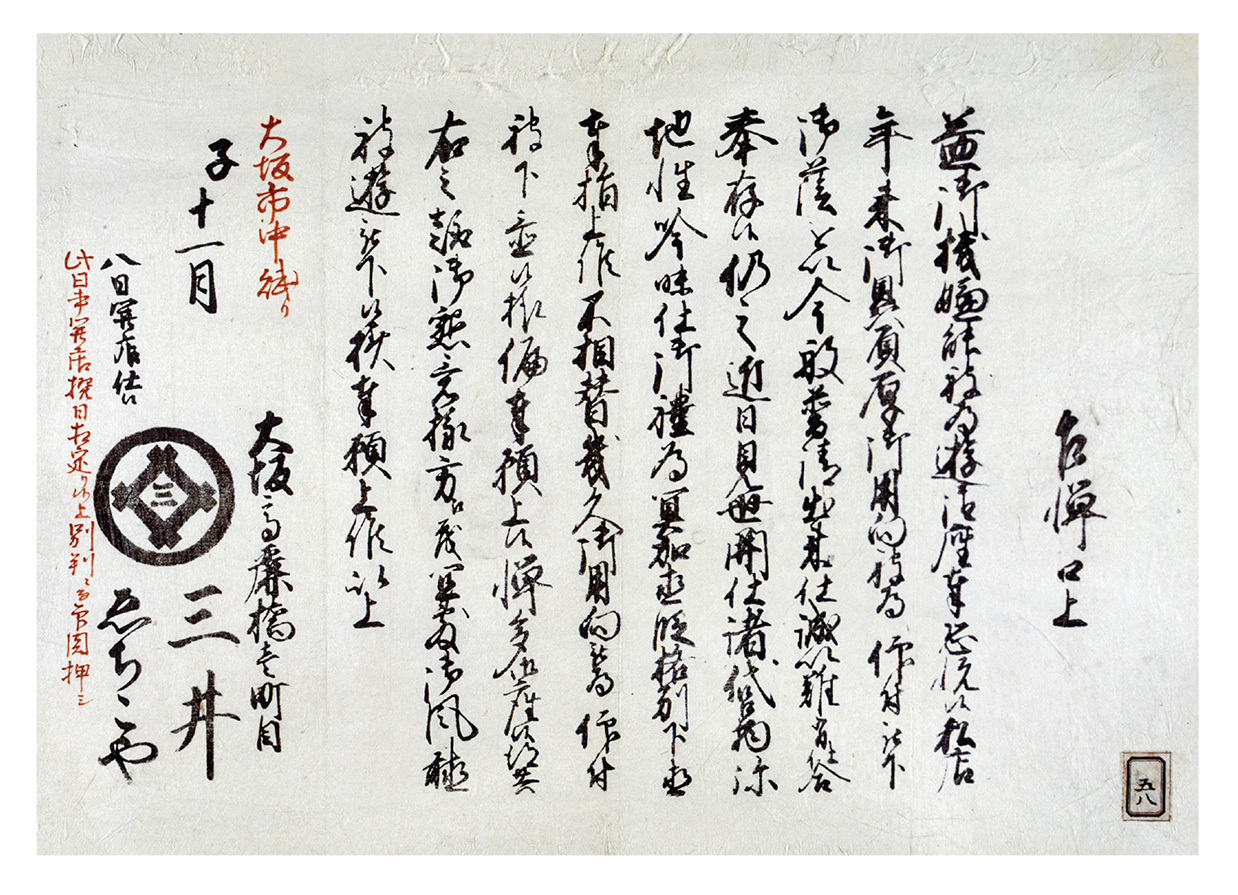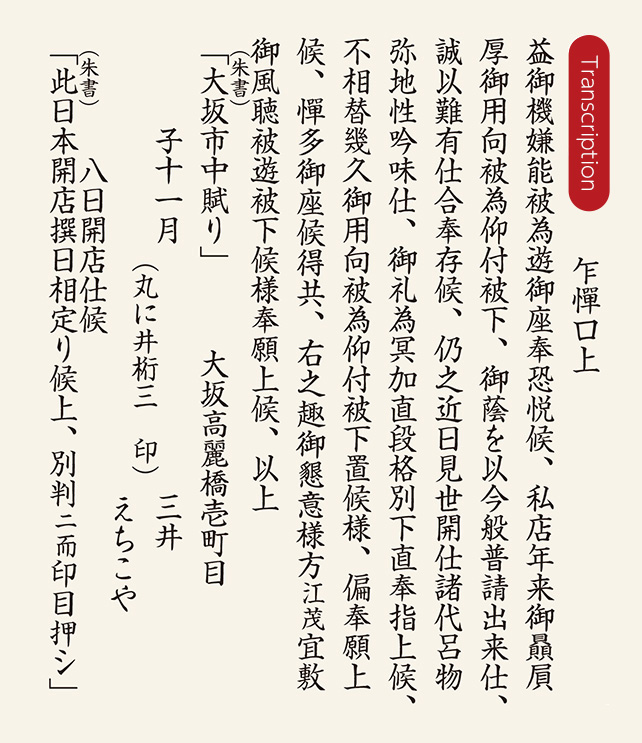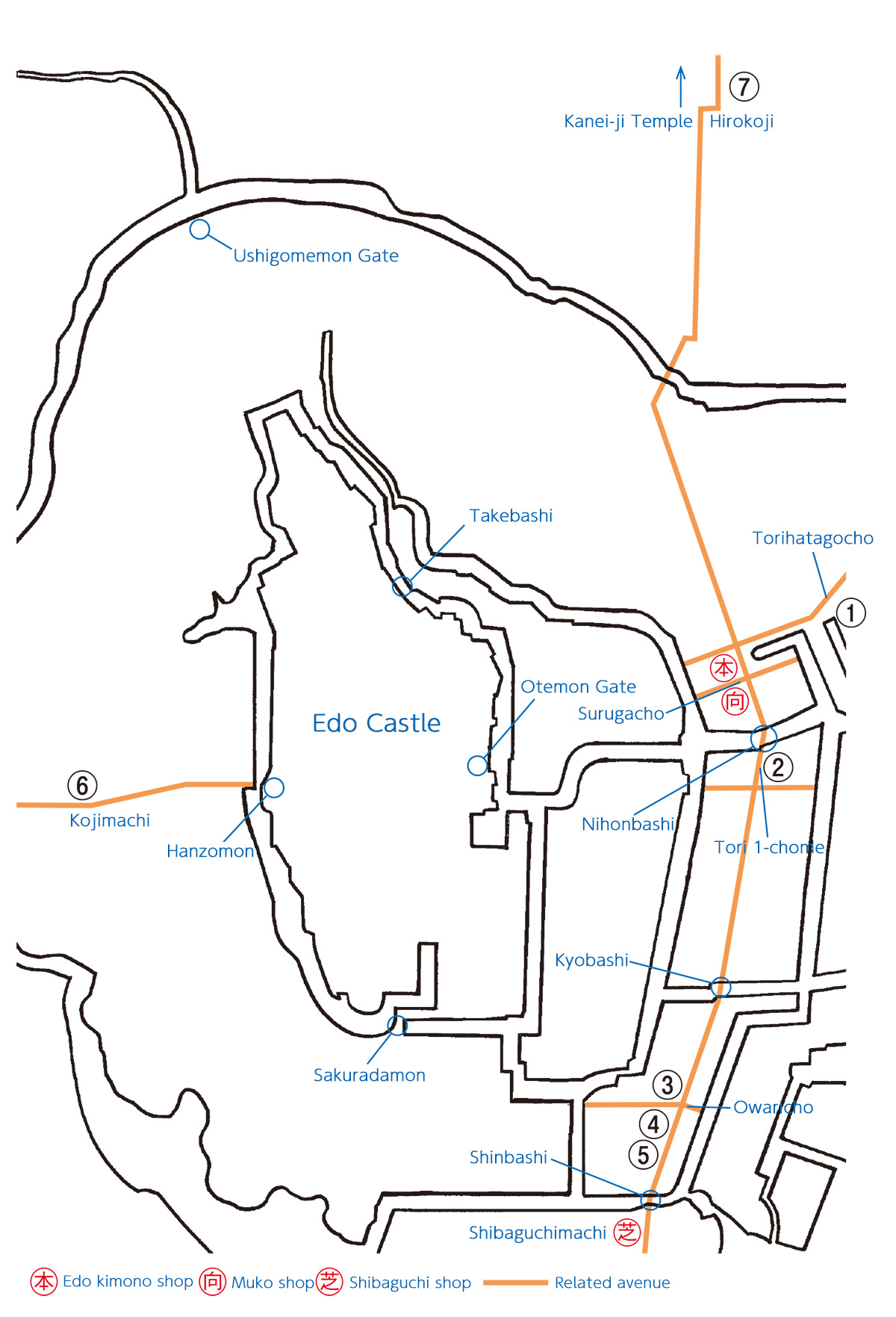14 Kimono Fabric Shops (3): Competition and Sales

Advertising Echigoya
The mottos of Echigoya, Mitsui’s kimono division, were tanasaki uri (storefront sales) and genkin kakene nashi (cash basis at fixed prices). To ensure the success of these commercial approaches, it was necessary to attract customers to Echigoya shops. One advertising method was to utilize flyers. It is said that Echigoya also lent numbered umbrellas to customers displaying the Mitsui emblem. As exemplified in the verse “Sudden rain/Mitsui lends umbrellas,” word of Echigoya’s umbrella rental service spread through senryu (short poetry similar to haiku) and other ways. As shown in a number of contemporary illustrations (→Fig. 14b), employees evidently made the rounds of wealthy customer residences carrying merchandise on their backs wrapped in furoshiki (carrying cloths) that displayed the Mitsui emblem. Color depictions of Echiogya’s gorgeous storefronts were also printed. Umbrellas and furoshiki were themselves advertisements for Echigoya, but their appearance in fiction, senryu, and illustrations was also a form of advertising.
Storefront Sales Rivals
In the latter half of the Edo period, other kimono fabric shops attempted to overtake Mitsui with a “cash basis at fixed prices” policy and a “storefront sales” style of selling. In Edo, huge kimono fabric shops like ① Daimaru, ② Shirokiya, ③ Hoteiya, ④ Kameya, ⑤ Ebisuya, ⑥ Iwakimasuya, ⑦ Ito Matsusakaya, and others competed fiercely to draw the most customers with storefront sales. Each store was located at the numbered places on the map (→Fig. 14c).
Intense Competition
The history of Echigoya is a history of competition with other kimono fabric sellers. As early as 1700, Echigoya embarked on cut-throat pricing competition with Daikokuya, emerging victorious through strict adherence to a low-margin, high-volume strategy. In the 1750s, Ebisuya and Kameya in Owaricho (now Ginza 6-chome), renovated and re-opened their shops and turned to price competition with Echogoya. The latter responded by opening its Shibaguchi shop (in present-day Shinbashi 1-chome) and successfully held its own. And in the 1790s, Daimaru in Torihatagocho (now Odenmacho), prompted by the Shogunate’s ban on luxury spending, aggressively promoted storefront sales of cotton fabric, becoming a threat to other kimono fabric shops, among them Echigoya. At the time, Echigoya was facing a financial slump and was forced to reform the management of its stores. This made it that much harder to defend against the intense competition from other kimono fabric shops, and Echigoya devised every possible means to increase customer traffic to its shops.

On February 19, 1837 (lunar calendar), the Osaka kimono shop in Koraibashi 1-chone burned down during the Oshio Heihachiro rebellion against the shogunate. On March 8, it re-opened for business, operating from a temporary shop. By July 1840, the shop had been largely rebuilt, and on November 8, a large-scale re-opening sale was held. This flyer advertised that sale. Approximately 700,000 copies were printed, with more than 120,000 being hand-distributed by sales staff throughout Osaka, even to the smallest back streets. Flyers are thought to have been allocated to ship’s crews for distribution outside Osaka. Flyers to outside of Osaka may have been distributed after the shop re-opening, and the wording was slightly changed. Flyers were also distributed when the Edo kimono shop moved to Surugacho in 1683 (→03). Whether in Edo or Osaka, Echigoya printed and distributed large numbers of flyers whenever there was a new shop opening or a major sale.
Description
The flyer opens with a greeting and thanks readers for their ostensible support during the rebuilding; states that the shop will re-open soon, with an offering of select-quality merchandise at specially low prices; requests readers’ continued patronage of the shop; and asks that they tell their friends about the re-opening, followed by the re-opening date.
The red ink on the flyer indicates that the opening date was not originally listed on the flyer, and that it was pre-printed and the date was stamped after the opening date was set.

From the second volume of Ehon Azuma Asobi (Picture Book of the Pleasure Spots of the Eastern Capital), by Katsushika Hokusai (1802). Part of a larger illustration of Mimeguri-jinja Shrine (located in present-day Sumida-ku). The shrine has long been closely associated with Mitsui.


